Related Research Articles

Cryptozoology is a pseudoscience and subculture that searches for and studies unknown, legendary, or extinct animals whose present existence is disputed or unsubstantiated, particularly those popular in folklore, such as Bigfoot, the Loch Ness Monster, Yeti, the chupacabra, the Jersey Devil, or the Mokele-mbembe. Cryptozoologists refer to these entities as cryptids, a term coined by the subculture. Because it does not follow the scientific method, cryptozoology is considered a pseudoscience by mainstream science: it is neither a branch of zoology nor of folklore studies. It was originally founded in the 1950s by zoologists Bernard Heuvelmans and Ivan T. Sanderson.
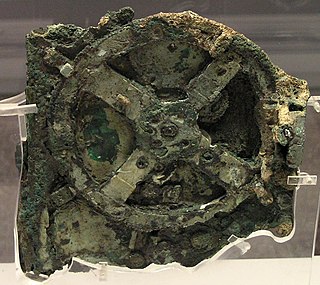
An out-of-place artifact is an artifact of historical, archaeological, or paleontological interest to someone that is claimed to have been found in an unusual context, which someone claims to challenge conventional historical chronology by its presence in that context. Some people might think that those artifacts are too advanced for the technology known to have existed at the time, or that human presence existed at a time before humans are known to have existed. Other people might hypothesize about a contact between different cultures that is hard to account for with conventional historical understanding.
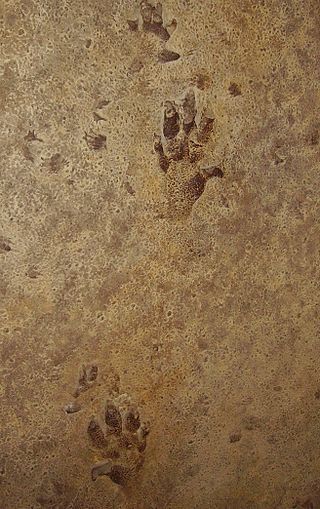
A trace fossil, also known as an ichnofossil, is a fossil record of biological activity by lifeforms but not the preserved remains of the organism itself. Trace fossils contrast with body fossils, which are the fossilized remains of parts of organisms' bodies, usually altered by later chemical activity or by mineralization. The study of such trace fossils is ichnology - the work of ichnologists.

Laetoli is a pre-historic site located in Enduleni ward of Ngorongoro District in Arusha Region, Tanzania. The site is dated to the Plio-Pleistocene and famous for its Hominina footprints, preserved in volcanic ash. The site of the Laetoli footprints is located 45 km south of Olduvai gorge. The location and tracks were discovered by archaeologist Mary Leakey and her team in 1976, and were excavated by 1978. Based on analysis of the footfall impressions "The Laetoli Footprints" provided convincing evidence for the theory of bipedalism in Pliocene Hominina and received significant recognition by scientists and the public. Since 1998, paleontological expeditions have continued under the leadership of Amandus Kwekason of the National Museum of Tanzania and Terry Harrison of New York University, leading to the recovery of more than a dozen new Hominina finds, as well as a comprehensive reconstruction of the paleoecology. The site is a registered National Historic Sites of Tanzania.

The Paluxy River, also known as Paluxy Creek, is a river in the U.S. state of Texas. It is a tributary of the Brazos River. It is formed by the convergence of the North Paluxy River and the South Paluxy River near Bluff Dale, Texas in Erath County and flows a distance of 29 miles (47 km) before joining the Brazos just to the east of Glen Rose, Texas in south central Somervell County.

A fossil track or ichnite is a fossilized footprint. This is a type of trace fossil. A fossil trackway is a sequence of fossil tracks left by a single organism. Over the years, many ichnites have been found, around the world, giving important clues about the behaviour of the animals that made them. For instance, multiple ichnites of a single species, close together, suggest 'herd' or 'pack' behaviour of that species.
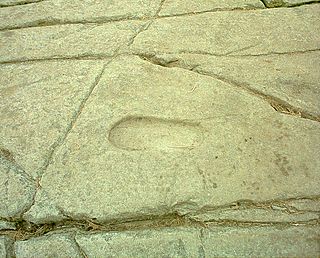
A petrosomatoglyph is a supposed image of parts of a human or animal body in rock. They occur all over the world, often functioning as an important form of symbolism, used in religious and secular ceremonies, such as the crowning of kings. Some are regarded as artefacts linked to saints or culture heroes.

The Creation Evidence Museum of Texas, originally Creation Evidences Museum, is a creationist museum in Glen Rose in Somervell County in central Texas, United States. Founded in 1984 by Carl Baugh for the purpose of researching and displaying exhibits that support creationism, it portrays the Earth as six thousand years old and humans coexisting with non-avian dinosaurs, disputing that the Earth is approximately 4.5 billion years old and non-avian dinosaurs became extinct 65.5 million years before human beings arose.
The Xalnene Tuff footprints are a geological academic controversy, concerning a 2005 discovery of 269 markings in a geological layer in the Valsequillo Basin, south of the city of Puebla, Mexico, which were originally interpreted to be human and animal footprints. The layer was variously dated to 40,000 years Before Present (BP) or 1.3 million years BP, both dates significantly before the currently accepted date for the settlement of the Americas. A 2010 study argues that the marks were made by recent mining activities.

Paleontology in Pennsylvania refers to paleontological research occurring within or conducted by people from the U.S. state of Pennsylvania. The geologic column of Pennsylvania spans from the Precambrian to Quaternary. During the early part of the Paleozoic, Pennsylvania was submerged by a warm, shallow sea. This sea would come to be inhabited by creatures like brachiopods, bryozoans, crinoids, graptolites, and trilobites. The armored fish Palaeaspis appeared during the Silurian. By the Devonian the state was home to other kinds of fishes. On land, some of the world's oldest tetrapods left behind footprints that would later fossilize. Some of Pennsylvania's most important fossil finds were made in the state's Devonian rocks. Carboniferous Pennsylvania was a swampy environment covered by a wide variety of plants. The latter half of the period was called the Pennsylvanian in honor of the state's rich contemporary rock record. By the end of the Paleozoic the state was no longer so swampy. During the Mesozoic the state was home to dinosaurs and other kinds of reptiles, who left behind fossil footprints. Little is known about the early to mid Cenozoic of Pennsylvania, but during the Ice Age it seemed to have a tundra-like environment. Local Delaware people used to smoke mixtures of fossil bones and tobacco for good luck and to have wishes granted. By the late 1800s Pennsylvania was the site of formal scientific investigation of fossils. Around this time Hadrosaurus foulkii of neighboring New Jersey became the first mounted dinosaur skeleton exhibit at the Academy of Natural Sciences in Philadelphia. The Devonian trilobite Phacops rana is the Pennsylvania state fossil.

Paleontology in New York refers to paleontological research occurring within or conducted by people from the U.S. state of New York. New York has a very rich fossil record, especially from the Devonian. However, a gap in this record spans most of the Mesozoic and early Cenozoic.

Paleontology in Massachusetts refers to paleontological research occurring within or conducted by people from the U.S. state of Massachusetts. The fossil record of Massachusetts is very similar to that of neighboring Connecticut. During the early part of the Paleozoic era, Massachusetts was covered by a warm shallow sea, where brachiopods and trilobites would come to live. No Carboniferous or Permian fossils are known from the state. During the Cretaceous period the area now occupied by the Elizabeth Islands and Martha's Vineyard were a coastal plain vegetated by flowers and pine trees at the edge of a shallow sea. No rocks are known of Paleogene or early Neogene age in the state, but during the Pleistocene evidence indicates that the state was subject to glacial activity and home to mastodons. The local fossil theropod footprints of Massachusetts may have been at least a partial inspiration for the Tuscarora legend of the Mosquito Monster or Great Mosquito in New York. Local fossils had already caught the attention of scientists by 1802 when dinosaur footprints were discovered in the state. Other notable discoveries include some of the first known fossil of primitive sauropodomorphs and Podokesaurus. Dinosaur tracks are the Massachusetts state fossil.

Paleontology in Wisconsin refers to paleontological research occurring within or conducted by people from the U.S. state of Wisconsin. The state has fossils from the Precambrian, much of the Paleozoic, some a parts of the Mesozoic and the later part of the Cenozoic. Most of the Paleozoic rocks are marine in origin. Because of the thick blanket of Pleistocene glacial sediment that covers the rock strata in most of the state, Wisconsin’s fossil record is relatively sparse. In spite of this, certain Wisconsin paleontological occurrences provide exceptional insights concerning the history and diversity of life on Earth.

Paleontology in Nebraska refers to paleontological research occurring within or conducted by people from the U.S. state of Nebraska. Nebraska is world-famous as a source of fossils. During the early Paleozoic, Nebraska was covered by a shallow sea that was probably home to creatures like brachiopods, corals, and trilobites. During the Carboniferous, a swampy system of river deltas expanded westward across the state. During the Permian period, the state continued to be mostly dry land. The Triassic and Jurassic are missing from the local rock record, but evidence suggests that during the Cretaceous the state was covered by the Western Interior Seaway, where ammonites, fish, sea turtles, and plesiosaurs swam. The coasts of this sea were home to flowers and dinosaurs. During the early Cenozoic, the sea withdrew and the state was home to mammals like camels and rhinoceros. Ice Age Nebraska was subject to glacial activity and home to creatures like the giant bear Arctodus, horses, mammoths, mastodon, shovel-tusked proboscideans, and Saber-toothed cats. Local Native Americans devised mythical explanations for fossils like attributing them to water monsters killed by their enemies, the thunderbirds. After formally trained scientists began investigating local fossils, major finds like the Agate Springs mammal bone beds occurred. The Pleistocene mammoths Mammuthus primigenius, Mammuthus columbi, and Mammuthus imperator are the Nebraska state fossils.
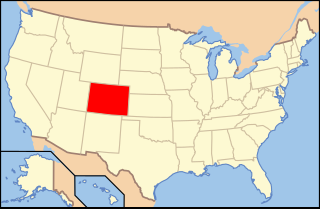
Paleontology in Colorado refers to paleontological research occurring within or conducted by people from the U.S. state of Colorado. The geologic column of Colorado spans about one third of Earth's history. Fossils can be found almost everywhere in the state but are not evenly distributed among all the ages of the state's rocks. During the early Paleozoic, Colorado was covered by a warm shallow sea that would come to be home to creatures like brachiopods, conodonts, ostracoderms, sharks and trilobites. This sea withdrew from the state between the Silurian and early Devonian leaving a gap in the local rock record. It returned during the Carboniferous. Areas of the state not submerged were richly vegetated and inhabited by amphibians that left behind footprints that would later fossilize. During the Permian, the sea withdrew and alluvial fans and sand dunes spread across the state. Many trace fossils are known from these deposits.

Paleontology in Utah refers to paleontological research occurring within or conducted by people from the U.S. state of Utah. Utah has a rich fossil record spanning almost all of the geologic column. During the Precambrian, the area of northeastern Utah now occupied by the Uinta Mountains was a shallow sea which was home to simple microorganisms. During the early Paleozoic Utah was still largely covered in seawater. The state's Paleozoic seas would come to be home to creatures like brachiopods, fishes, and trilobites. During the Permian the state came to resemble the Sahara desert and was home to amphibians, early relatives of mammals, and reptiles. During the Triassic about half of the state was covered by a sea home to creatures like the cephalopod Meekoceras, while dinosaurs whose footprints would later fossilize roamed the forests on land. Sand dunes returned during the Early Jurassic. During the Cretaceous the state was covered by the sea for the last time. The sea gave way to a complex of lakes during the Cenozoic era. Later, these lakes dissipated and the state was home to short-faced bears, bison, musk oxen, saber teeth, and giant ground sloths. Local Native Americans devised myths to explain fossils. Formally trained scientists have been aware of local fossils since at least the late 19th century. Major local finds include the bonebeds of Dinosaur National Monument. The Jurassic dinosaur Allosaurus fragilis is the Utah state fossil.
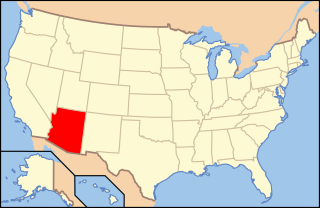
Paleontology in Arizona refers to paleontological research occurring within or conducted by people from the U.S. state of Arizona. The fossil record of Arizona dates to the Precambrian. During the Precambrian, Arizona was home to a shallow sea which was home to jellyfish and stromatolite-forming bacteria. This sea was still in place during the Cambrian period of the Paleozoic era and was home to brachiopods and trilobites, but it withdrew during the Ordovician and Silurian. The sea returned during the Devonian and was home to brachiopods, corals, and fishes. Sea levels began to rise and fall during the Carboniferous, leaving most of the state a richly vegetated coastal plain during the low spells. During the Permian, Arizona was richly vegetated but was submerged by seawater late in the period.
The geological history of North America comprises the history of geological occurrences and emergence of life in North America during the interval of time spanning from the formation of the Earth through to the emergence of humanity and the start of prehistory. At the start of the Paleozoic Era, what is now "North" America was actually in the Southern Hemisphere. Marine life flourished in the country's many seas, although terrestrial life had not yet evolved. During the latter part of the Paleozoic, seas were largely replaced by swamps home to amphibians and early reptiles. When the continents had assembled into Pangaea, drier conditions prevailed. The evolutionary precursors to mammals dominated the country until a mass extinction event ended their reign.
Brian Regal is an American historian of science, skeptic and writer. He is an associate professor of the history of science at Kean University in New Jersey.
Gwyneddichnium is an ichnogenus from the Late Triassic of North America and Europe. It represents a form of reptile footprints and trackways, likely produced by small tanystropheids such as Tanytrachelos. Gwyneddichnium includes a single species, Gwyneddichnium major. Two other proposed species, G. elongatum and G. minore, are indistinguishable from G. major apart from their smaller size and minor taphonomic discrepancies. As a result, they are considered junior synonyms of G. major.
References
- 1 2 Regal, Brian (2009). Pseudoscience: A Critical Encyclopedia. Greenwood. p. 22. ISBN 978-0-313-35507-3
- 1 2 3 4 "The "Meister Print" An Alleged Human Sandal Print from Utah". TalkOrigins. Retrieved 4 May 2019.
- ↑ "Tripping Over a Trilobite: A Study of the Meister Tracks". National Center for Science Education. Retrieved 4 May 2019.
- ↑ Strahler, Arthur N. 1987. Science and Earth History. Prometheus Books. pp. 459-461. ISBN 1-57392-717-1
- ↑ The Antelope Springs ‘footprint’. Bad Archaeology. Retrieved 4 May 2019.